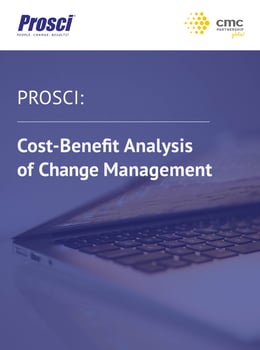In this blog, I’ll be discussing Prosci’s approach to writing a business case for change management, and the eight sections that it comprises of.
But, before I begin, just so we’re all on the same page- what do we mean by a business case?
In this context, our business case will capture the reasoning for integrating change management practices into your project(s). The business case needs to convince the decision maker to take action.
Why do we need a business case for change management?
But why? What is the purpose of making the effort of putting together a formal business case for change management?
At CMC Global, we meet hundreds of individuals every year through our training programmes and advisory work, from many different backgrounds and organisations.
One common denominator that comes out of our conversations, is that the subject of applying change management is often met with scepticism in their organisation. There are common questions and themes that arise when the topic of change management is discussed:
- “I don’t see the value of change management”
- “Change management is soft and fuzzy?”
- “What does it mean to apply change management to a project?”
- “Change management is different to what I know”
Therefore we use our business case to cut through this scepticism and doubt, which in turn, gives us the level of credibility we need, in order for decision makers to allow us to begin our change management work, and to support it.
Download: Cost-Benefit Analysis of Change Management
Forming the structure of your business case
At the beginning of this blog I mentioned Prosci’s eight sections that will comprise our business case. These sections (with Prosci’s definitions) include:
- Executive Summary- “Give a succinct and concise presentation of vital information. This section summarises your story.”
- Situational Assessment and Problem Statement- “Directly connect the results, outcomes, value and benefit realisation of the initiative to the people side of change. You do not need to explicitly mention change management here.”
- Project Description- “Present the high-level description, scope, and objectives for the project or task. In this case, the task is applying change management.”
- Solution Description- “Summarise your solution of applying change management and present milestones, work streams and measurements for change management.”
- Cost-Benefit Analysis- “Clearly present the costs and anticipated benefits of applying change management.”
- Implementation Timeline- “Solidify the structured approach and build credibility by mapping change management milestones to existing project milestones, such as kickoff and go-live.”
- Critical Assumptions and Risk Assessment- “Present a SWOT analysis and dependencies for applying change management.”
- Conclusions and Recommendations- “Clearly articulate the "ask" (resources, funding, authorisation, support, etc.). This builds confidence that your solution solves the presented situation.”
As mentioned, the structure and definitions that we are highlighting here, was comprised by Prosci and forms part of their overall Business Case for Change Management Template tool, available to purchase via their online portal.
Watch Webinar: How to Write a Business Case for Change Management
Remember those four questions and themes that I mentioned earlier in the blog? Well, this structure for our business case will go a long way to answering them. Which is our goal, right?
1. What does it mean to apply change management to a project?
This question will be answered within our Project and Solution Descriptions. The Project Description provides the description, scope, and objectives, whilst the Solution Description provides the information regarding work streams, milestones and deliverables.
2. I don’t see the Value of Change Management
We’re going to use the Situational Assessment and Problem Statement section to answer this. In this section you’ll be drawing the direct connection between results and outcomes and the people side of change. You’ll also be showing the dependencies for benefit realisation and value creation, and our ability to prepare, equip and support your people through change.
3. Change Management Seems Soft and Fuzzy
Taking the time and effort to write a business case for change management goes a long way to addressing this. The nature of a business case means you’re providing a formal, structured presentation of your rationale and approach. How’s that soft and fuzzy!?
4. Change Management is Different to what I’m used to
Change Management may be an alien concept to your decision makers, but the idea of a business case will be something they know very well.
In your business case, you’ll be using words like ‘description’, ‘scope’ and ‘work streams’. We’re speaking their language!
As Nelson Madela once said, “If you talk to man in a language he understands, that goes to his head. If you speak to a man in his language, that goes to his heart.”
In conclusion, providing a formal business case can go a long way to building your credibility. This will increase the likelihood that you’ll achieve both executive buy-in and approval, to begin your change management work.
I hope this blog provides you with a starting point, and acts as a guide to work with when putting together your change management business case.
For more information on this topic, we encourage you to join us for our FREE Prosci change management webinar, ‘How to Write a Business Case for Change Management’, which builds on the information provided in this blog.


